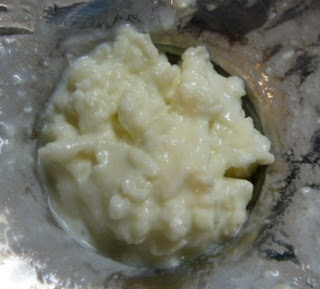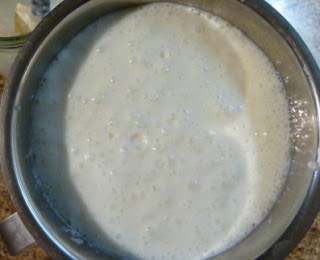

| Visitors Now: | |
| Total Visits: | |
| Total Stories: |

| Story Views | |
| Now: | |
| Last Hour: | |
| Last 24 Hours: | |
| Total: | |
Sustainable Cultured Milk
Even though we produce our own milk, we rarely actually drink it. I’ve shown you the dairy products I make (“Ziggy Milk, Ziggy Butter, Ziggy Mozz“), but mostly we consume milk as yogurt. Nearly every day in fact. I know I’ve mentioned it frequently and have shown you my non-electric method of yogurt making, “Easy Peasy Homemade Yogurt“, as well as how I make yogurt cheese. The only thing that bothers me about yogurt, is that I have to keep buying new starter. The good guy bacteria in the culture have a life span, and eventually the product changes as the culture ages. Every so often I have to buy some fresh yogurt to start again.
Another cultured milk product is kefir. I’d seen it as a fruit flavored drink in the dairy section at the grocery store. I never considered buying it, because most commercial products like this are too sweet and with too many nonessential synthetic ingredients. On top of that, commercial kefir is pasteurized, to kill anything alive in it, including the beneficial bacteria I’d be buying it for in the first place. Then I read that not only does kefir culture (called grains) not wear out, it actually perpetuates itself. If one takes proper care of it, that means never-ending cultured milk!
Because kefir grains multiply, it is easy to find them for sale, or for free from folks who just need to find a home for their ever increasing supply. Such was the case for me, and for the price of postage, I obtained my very own milk kefir from a gal on one of the goat lists I subscribe to.
 |
| Kefir grains |
Making kefir is even easier than making yogurt. Just add one or two tablespoons of kefir grains to about 2 cups of milk. Cover to keep fruit flies out, and let sit on the counter for 24 – 48 hours. Sourness and thickness are controlled by the length of time it’s allowed to sit. Then strain, put the newly made kefir into the fridge, get a clean jar, and start a new batch.
I was very curious as to it’s taste. We eat our yogurt mostly on cereal in the morning, so this seemed a good substitute. But. It doesn’t taste quite the same. Tangy from the beneficial bacteria, yes. But because it contains nutritional yeasts, it’s a bit bubbly and has a different flavor.
 |
| Kefir after I’ve poured it into the strainer. |
The only word I can think to describe it is effervescent.
I’m just starting my experiments but eventually should have lots to share about what I’m learning. Two books with directions for making it are Nourishing Traditions by Sally Fallon, and Wild Fermentation by Sandor Katz. And of course there are tons of informational and how-to articles around the internet. The best I found are Dom’s kefir webpages:
- About kefir grains and kefir
- how to make kefir (with lots of recipe links)
- and kefir FAQs.
Its uses intrigue me, in particular cheese, not only soft yogurt type cheese, but harder cheeses as well. Also bread making and lacto-fermenting; all things I already do. According to Wikipedia, it can be used in making sourdough bread and is an ingredient in some recipes for borscht.
Right now I’m working with milk kefir grains, but there are other types. Water kefir is commonly used with juices and I can already see that I need some of these grains too.
I am looking forward to experimenting with this. There seem to be a lot of possibilities for it’s use, not to mention the nutritional benefits. Plus, I’m happy to be able to culture my goat milk without needing to continually replace the culture. After I’ve experimented a bit, I’ll let you all know what I figure out.
2012-11-27 10:26:08
Source: http://www.5acresandadream.com/2012/10/sustainable-cultured-milk.html
Source:


